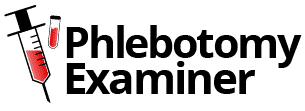The demand for qualified phlebotomists has never been higher. But, just because the need for trained professionals is significant doesn’t mean that you shouldn’t spend time perfecting your resume.
You need to develop a resume that helps you to stand out from the crowd. Putting down the training course you took is no longer enough. Although there are more entry level phlebotomy vacancies, you’ll also discover that more candidates are fighting it out for the best jobs.
Phlebotomists can work in a variety of different types of organizations. Certain facilities might be looking for different personal qualities. But, no matter where you apply, you need to make sure your resume is an accurate reflection of what you can offer a potential employer.
Writing the ideal resume can feel overwhelming if it’s something that you’ve never done before. But, there are some tips that you can use to make your phlebotomy resume look amazing.
What Should I Include in My Phlebotomy Resume?
We will focus on what a good phlebotomy resume should include. We’ll go over a basic outline and what you should be able to fill in for each section. You can use this as a guide if you’re getting into the phlebotomy field or you’ve just completed training.
It’s never a bad idea to keep your resume updated and add any accomplishments or extra skills. But, we’ll be focusing mainly on how you can make your resume stand out when you’re just getting started as a phlebotomist and want to get hired right away.
Phlebotomist Resume Objective
Every great resume should start out with an objective. The objective should be relatively short and get straight to the point. Think of it as the first impression a potential employer will have of you. If it’s too long and wordy, they might get disinterested and move on.
The objective of your phlebotomy resume should cover two significant things:
- It should state what kind of experience you hope to have as a phlebotomist. Again, this should only be a sentence or two.
- It should give your potential employer an idea about your goals within a phlebotomy career. These goals can be personal. Maybe your goals are to help many people or to jumpstart a career as a nurse. Think about what you want in the short-term and long-term and concisely include them.
Here’s an example of a strong objective statement for a phlebotomy resume:
- Seeking a challenging and rewarding phlebotomy technician position. My goals are to use my learned skills and experience to advance my career and take advantage of opportunities.
Everyone’s objective statement will be different. It’s best to keep it to no more than three sentences. Think about what makes you want to be a phlebotomist and why and include that in a summarized version for a truly stand-out objective.
[su_list icon=”icon: check-circle”]
Summary of Qualifications
Some resumes use a summary of qualifications in place of an objective statement. It’s up to you which format you choose to use. But, a good rule of thumb is to use a summary of qualifications if you’re applying for a specific job at a particular place. This is because you can show off your phlebotomy qualifications based on that job’s description.
A summary of qualifications is a way to introduce your strengths and skills. But, you can do it in a way that matches a specific job description. You can list your skills in this section, but they should be a reflection of what the employer is looking for. Let’s take a look at an example of a job posting, and what a strong summary of qualifications might be.

- Job posting: Looking for a strong team-player to work in a busy hospital environment. Must have skills in venipuncture, finger sticks, and blood collection procedures. CPR-certified is a plus.
- Summary of qualifications: Experienced in venipuncture. Does well with finger sticks and work with butterfly needles and syringes. Excels in working with others and works well under pressure. Completed National Phlebotomy Certification exam as well as CPR training.
Not only does this summary match what the job description is looking for, but it sneaks in other skills. This option is a great way to let the employer know you’re a perfect fit, and why.
Including Your Strengths and Skills
It’s easy to think that the most critical part of a phlebotomy resume is your work history. While that can make a big difference, you can beef up your resume a bit by including your strengths and skills.
Keep in mind that not all these skills have to reflect a career in phlebotomy. Sometimes, a skill like ‘punctual’ can be more appealing to an employer than you may realize. So, don’t be afraid to include whatever you think makes you unique from other possible employees.
Some examples of skills might include:
- Knowledge of medical terminology
- Knowledge of different venipuncture methods and sites
- Energetic
- 200+ successful blood draws
- Team-player
- Bilingual (Spanish and English)
- Highly organized
When you’re writing down your list of skills, it’s important not to think in generalities. Almost everyone who wants a phlebotomy job will probably include something in their strengths about how many blood draws they’ve done. They’ll likely also include what they know about medical terms and the anatomy of the human body, etc.
With that in mind, it’s up to you to include some things that will help your resume stand out from everyone else’s. Many times, it’s the more personal skills and strengths that can catch an employer’s eye and might make them hire you over someone else.
Past Work Experience
Most employers want to know where you’ve worked before and how that can contribute to your career at their facility. When you list your previous places of employment, don’t just say where you worked and when. You should list the duties and responsibilities you had at each job. The more details you can give about your role in your previous jobs, the better.
For example, if you’ve worked for another medical facility as a phlebotomist, some of the duties you include might be:
- Performed routine blood draws
- Extremely familiar with phlebotomy equipment, including butterfly needles
- Verified collection of different specimens
- Communicated with doctors and patients about their orders
Your list of responsibilities from past jobs will be unique to you. This is another area where you should avoid using generalities about phlebotomy jobs. Or, keep them to a small amount and focus on what you did that would be appealing to an employer. You can also include internships if they are applicable.
When listing your work history, always start with the most recent experience first. Then, work your way down in that order.
[/su_list]
How to Improve a Phlebotomist Resume with No Experience
When you’re just starting out as a phlebotomist, it can be hard to fill in your work experience. Jobs you may have had in the past can show that you’re a dedicated worker. But, most medical employers are going to want you to have experience in the healthcare industry.
You’ll have to perform many successful venipunctures throughout your training. Each program has a different number that a student has to reach to pass. But, it’s usually over 100.
While you can use that in your resume, it’s not going to help you to stand out from any other candidate, since everyone has to go through similar training procedures.
Most hospitals and medical facilities want phlebotomists they hire to have at least a little experience. Otherwise, you may have to work with a supervisor if you do get hired.
If you’re having trouble getting hired after training, there are ways to gain experience:
- Volunteer: Volunteering is one of the best ways to get phlebotomy experience quickly. It’s more than just hospitals and clinics that are in great need of phlebotomists. Many different organizations need good phlebotomy technicians to help out. While these organizations can’t always pay you, they are great for gaining experience and adding to your resume. Some places that often need phlebotomy volunteers include nursing homes, blood banks, the Red Cross and veterans’ hospitals.
- Internship: Some hospitals and clinics give internships to training graduates. Internships are usually unpaid, but you can learn a lot and gain quite a bit of experience.
- On-the-job training: Certain medical facilities will hire you with no experience if you agree to on-the-job training. In these instances, you’ll be working with a supervisor, and you won’t be able to work alone for a period of time. Unlike internships, on-the-job training can offer you some type of salary. But, it may be limited at first until you’re able to work on your own.
- Hospital training: Hospitals are especially in need of phlebotomists. So, some of them offer their own training programs. They do this in hopes that the students who go to these programs will want to work in their facilities. Many times, they’ll make these programs somewhat specific to their facility. This includes things like their own safety rules and procedures, etc. You may be more likely to get hired right away by that particular hospital if you train this way.

As you can see, there are ways to gain experience. So, if you’re struggling with the ‘work experience’ section of your resume, try one of these options. The more hours you can add to your list, the better.
Where Did You Complete Your Training?
The next section of your phlebotomy resume should focus on where you got your schooling/training.
It’s important to employers that you trained with an accredited program. For your educational background, it’s okay to list the school/program you attended, and when you were there. It’s also a good idea to list any extra certifications you might have.
Not every state currently demands that phlebotomists complete a certification exam. But, it could be another thing that helps you to stand out from the competition on a resume.
Phlebotomy students who go a step further and receive certification are often picked above their counterparts. You may also start at a higher salary than a technician who isn’t certified.
Be sure to list any other certifications you might have, such as CPR, etc. Any extra qualifications to make your resume stand out can be helpful.
As you did with your work experience, list your most recent training or schooling experience first. Then, work your way down to the least recent. Be sure to include when you graduated high school and the name of that school.
References
Though it’s not always necessary, you can choose to include two or three references at the bottom of your resume. These should only be added after all other important information and details. If the job you’re applying for had an application to be filled out, they might already have a spot to list your references. So, be sure the references are consistent on both documents.
If you do choose to add references to your resume, make sure you let them know that you include them, so they aren’t put off if they get a phone call or email from an employer. This doesn’t mean you should tell them what to say, but you should choose someone you trust and someone who will be honest about your skills.
You can choose anyone you want as a reference but try not to make them all family members. The best thing you can do is list someone you’ve shared a work experience with in the past. Even former bosses or managers can be great resources. These types of people will give a potential employer the best idea of what you’re like in a work environment.
What Not to Include in Your Resume
Now that you know the different sections to include and how to put them together, it’s important to know what to avoid in creating a good resume. Unfortunately, there are a lot of little traps that can end up being big red flags for employers. Just a few of these mistakes can move your resume to the bottom of the pile for someone who might be hiring.
[su_list icon=”icon: check-circle”]
Avoid these pitfalls when you’re setting up your resume:
- Don’t use language in the first person. Saying things like “I” or “me” can be considered unprofessional and may make your resume look sloppy.
- Simple is better. Some people can fall into the trap of using big, complicated words. When an employer has dozens (if not more) of resumes to look at, they don’t want things to be over-complicated. Choose words and phrases that are clear, concise, and to the point.
- Don’t focus on using medical terms and other industry language/jargon. This won’t get you any extra points. While using the right language for the position you want is essential, it’s easy to overdo it. Again, keep things as simple as possible with your language.
- Never lie or exaggerate about any of the experiences listed on your resume. This includes past jobs, certifications, and education. Many employers will do a background check before they consider hiring you. If something doesn’t line up with your resume, it’ll be regarded as a huge red flag, and you likely won’t get the job.
[/su_list]

What’s the Perfect Format for a Phlebotomy Resume?
There is no one ‘perfect’ format to follow for your resume when you’re putting it together. You can go in the order we’ve listed out in this article or try something different.
But, there are a few concrete things to keep in mind when you’re considering formatting:
- Always make sure your objective statement or summary of qualifications is at or near the top. The idea is that this will be the first thing an employer reads to get a better idea of who you are. Make it easy to find right away.
- Any time you list work experience or education, start with the most recent examples first.
- Highlight the best things about yourself and your career closer to the top of the resume, if possible. Remember, HR professionals probably have a lot of resumes to look at if they’re hiring. They’re more likely to read the top half of your resume. If you can showcase the best parts of your work and education there, you can pique their interest.
- If you have no work experience, consider putting your education/training before your work history. This is a subtle way to highlight the experience you do have first.
- Make your resume fit each job you’re applying for. Sending out twenty of the same resumes to different hospitals, etc., is unproductive. You can quickly make quick changes to your document to fit the job description and title the facility is looking for. Doing things like this will let that employer know you’re interested in their position, not just ‘any’ position.
Does it Matter What My Resume Looks Like?
There are dozens of different ways to design your resume. The best thing you can do is make it personal to you. While using a template can be helpful, you shouldn’t just choose a template that lists your strengths and experience and nothing else.
With that in mind, there are a few things to keep in mind that can help to give your resume a little ‘boost.’
Choosing one or two of these tips can be helpful in getting your name to stand out before the employer even reads your entire document:
[su_list icon=”icon: check-circle”]
- Choose a theme that helps you get noticed, but still look professional. Something sleek with calm colors is a great way to make your resume look just different enough from someone else’s. It’s a great way to add a subtle touch instead of just using a standard white document.
- Make your contact information easily visible at the top of the resume. Some people wait until the last line or two or even use their contact info as a footer. Whether you put your information in the corner or as the first thing on the page, the employer should be able to see it easily so they can get ahold of you.
- In some cases, you can go for a more modern approach and include your picture and a few more personal details about you. Some employers appreciate this approach because it lets them know more about you before having to call you in for an interview, etc.
How you design your resume is up to you. It shouldn’t be too loud and confusing, but it’s okay to include some color to get noticed. It should be a reflection of who you are and your sense of professionalism.
While there is a massive demand for phlebotomists, there are also many people applying for these jobs. It’s important to do as much as you can to show why you might be a better candidate for a job than someone else. So, a strong resume really matters.
Thankfully, it’s not too complicated to put together a solid resume once you have a format in mind. By keeping things short and simple and highlighting your best qualities, you can put together an impressive document.
The perfect job is out there for you. The right resume can help you land it sooner and kick off your career as a phlebotomy technician.
[/su_list]






